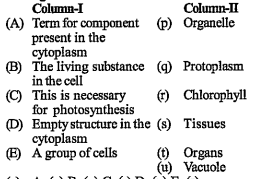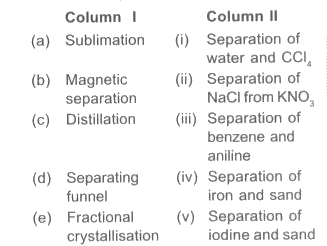Identify the chemical changes from the following
I.Burning of magnesium in air
II.Tarnishing of silver spoon
III.Sublimation of iodine
IV.Electrolysis of water
Select the correct option from the following given codes
I and II
I and III
I,II And IV
all of these
The correct Answer is:C
To identify the chemical changes from the given options, we will analyze each one based on the definition of a chemical change, which is characterized by the formation of new products through a chemical reaction.
1. Burning of Magnesium in Air:
- When magnesium burns in air, it reacts with oxygen to form magnesium oxide (MgO).
- This process involves a chemical reaction where new products are formed.
- Conclusion: This is a chemical change.
2. Tarnishing of Silver Spoon:
- Tarnishing occurs when silver reacts with sulfur compounds in the air, leading to the formation of silver sulfide (Ag2S), which is black in color.
- This reaction results in the formation of a new product (Ag2S).
- Conclusion: This is a chemical change.
3. Sublimation of Iodine:
- Sublimation is the process where solid iodine transitions directly to gas without passing through a liquid state.
- This change only involves a physical state change and does not result in the formation of new products.
- Conclusion: This is a physical change, not a chemical change.
4. Electrolysis of Water:
- During electrolysis, water is broken down into hydrogen gas (H2) and oxygen gas (O2) when an electric current is passed through it.
- This process involves a chemical reaction that produces new substances (H2 and O2).
- Conclusion: This is a chemical change.
Final Identification of Chemical Changes:
- The chemical changes identified are:
- I. Burning of magnesium in air (Chemical Change)
- II. Tarnishing of silver spoon (Chemical Change)
- IV. Electrolysis of water (Chemical Change)
- The only option that is not a chemical change is:
- III. Sublimation of iodine (Physical Change)
Correct Options:
The correct options indicating chemical changes are I, II, and IV.
- When magnesium burns in air, it reacts with oxygen to form magnesium oxide (MgO).
- This process involves a chemical reaction where new products are formed.
- Conclusion: This is a chemical change.
- Tarnishing occurs when silver reacts with sulfur compounds in the air, leading to the formation of silver sulfide (Ag2S), which is black in color.
- This reaction results in the formation of a new product (Ag2S).
- Conclusion: This is a chemical change.
- Sublimation is the process where solid iodine transitions directly to gas without passing through a liquid state.
- This change only involves a physical state change and does not result in the formation of new products.
- Conclusion: This is a physical change, not a chemical change.
- During electrolysis, water is broken down into hydrogen gas (H2) and oxygen gas (O2) when an electric current is passed through it.
- This process involves a chemical reaction that produces new substances (H2 and O2).
- Conclusion: This is a chemical change.
- The chemical changes identified are:
- I. Burning of magnesium in air (Chemical Change)
- II. Tarnishing of silver spoon (Chemical Change)
- IV. Electrolysis of water (Chemical Change)
- The only option that is not a chemical change is:
- III. Sublimation of iodine (Physical Change)
The correct options indicating chemical changes are I, II, and IV.
Similar Questions
Knowledge Check
- Question 1 - Select One
Identify the chemical changes from the following
I.Burning of magnesium in air
II.Tarnishing of silver spoon
III.Sublimation of iodine
IV.Electrolysis of water
Select the correct option from the following given codesAI and IIBI and IIICI,II And IVDall of these - Question 2 - Select One
Select the correct statement from the following given options.
ADarwinian variations are small and directiorilessBFitness is the end result of the ability to adapt and gets selected by natureCAll mammals except whales and camels have seven ceNical vertebraeDMutations are random and directional - Question 3 - Select One
Match I with II and select the correct option from the given codes.
 Aa - (iii), b – (i), c – (ii)Ba - (iii), b - (ii), c – (i)Ca - (i), b – (ii), c – (iii)Da - (ii), b – (i), c- (iii)
Aa - (iii), b – (i), c – (ii)Ba - (iii), b - (ii), c – (i)Ca - (i), b – (ii), c – (iii)Da - (ii), b – (i), c- (iii)
Match column I and II and select the correct option from the given codes.
 View Solution
View SolutionMatch column I and II and select the correct option from the given codes.
 View Solution
View SolutionMatch the following and select the correct option from the codes given below
 View Solution
View SolutionMatch the following and select the correct option from the codes given below.
 View Solution
View SolutionIdentify the correct statement from the following in a chemical reaction
View Solution



